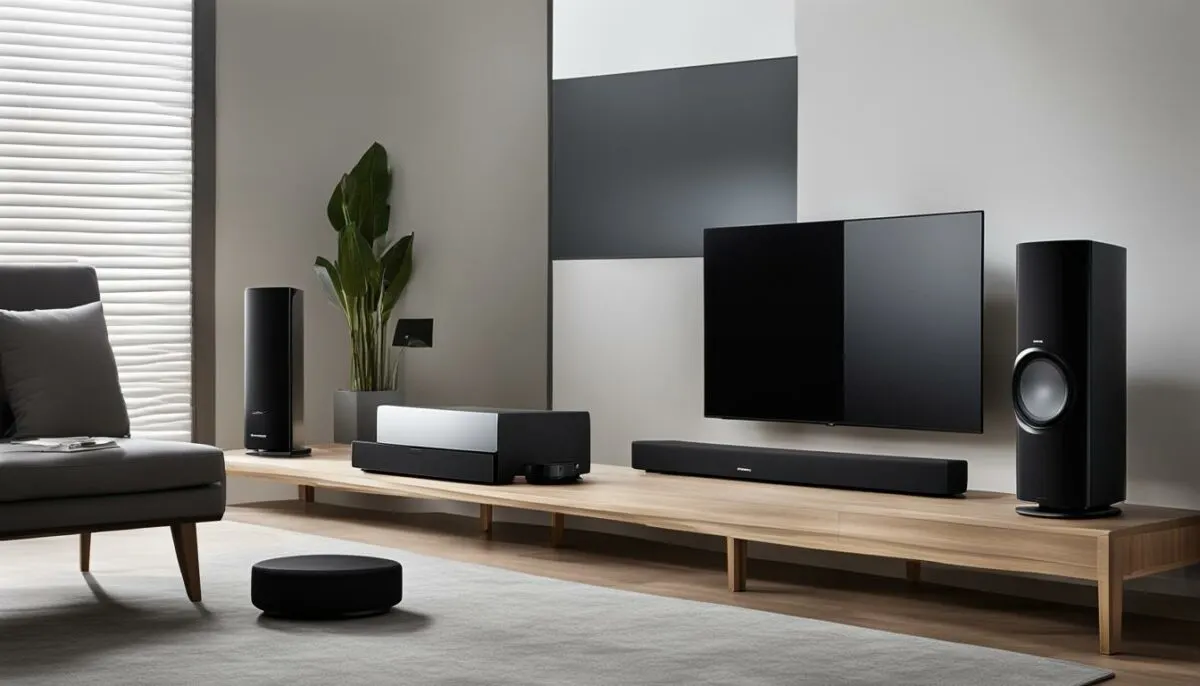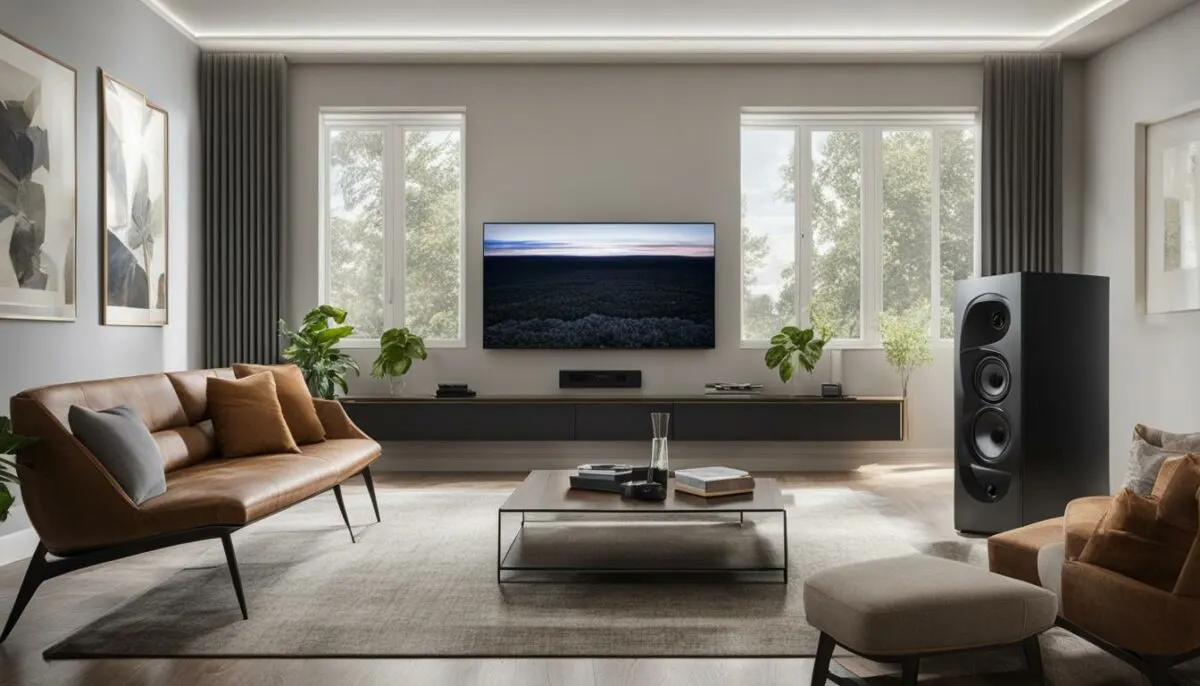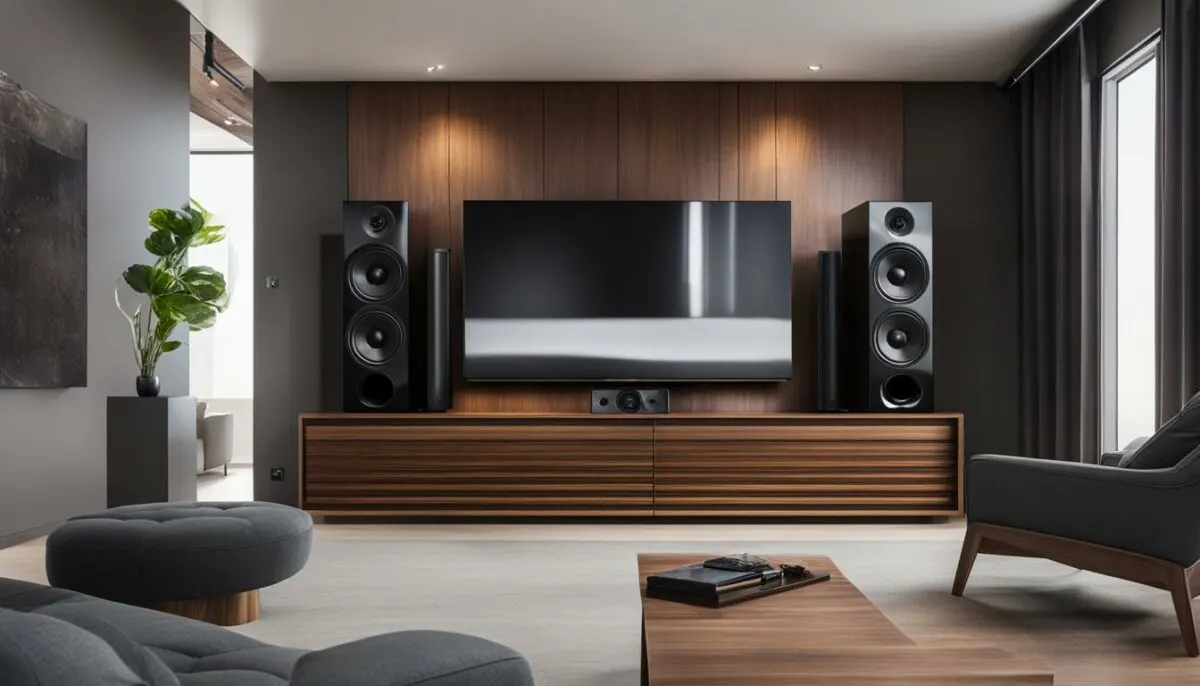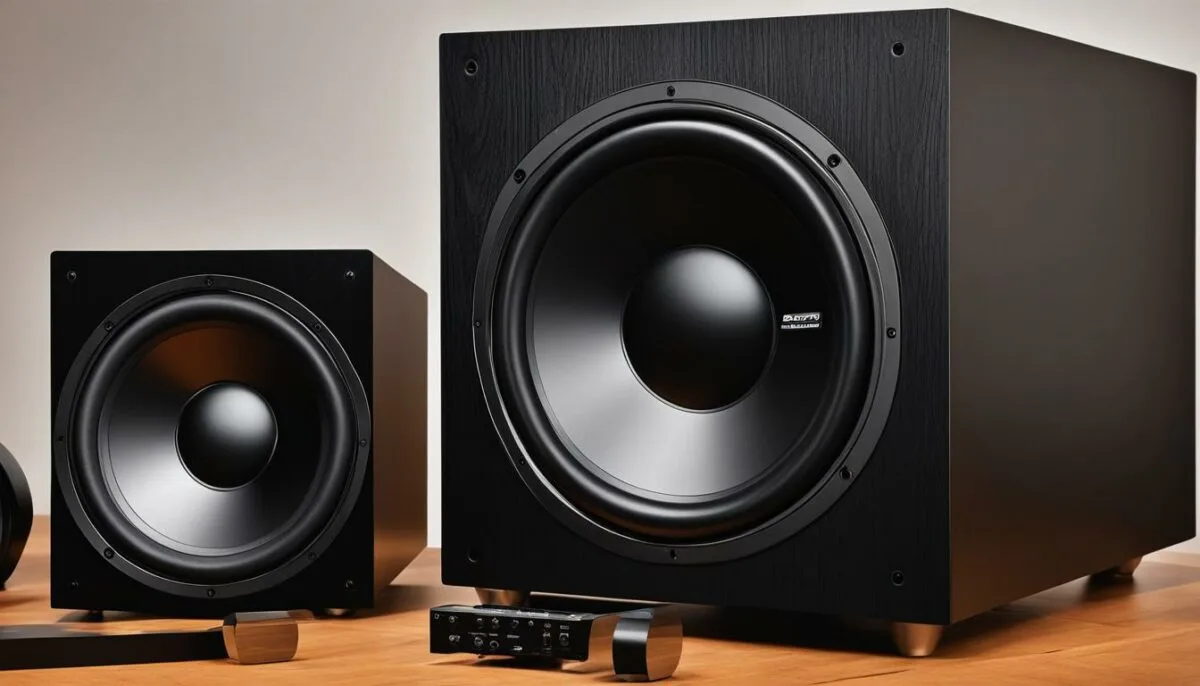When setting up your soundbar and subwoofer, finding the optimal placement for the subwoofer is crucial for an immersive audio experience. The location of the subwoofer can significantly impact the sound quality, ensuring that you feel every bass rumble and low-frequency detail.
So, where should you place your subwoofer with a soundbar? The answer depends on several factors, including your room size, subwoofer type, and personal preferences. Let’s explore some subwoofer placement tips to help you optimize your soundbar setup.
Key Takeaways:
- Consider the room size and layout when deciding where to place your subwoofer for optimal sound quality.
- Popular subwoofer placements include the front of the room, next to the TV, and in a corner.
- Leave at least six inches of space between the subwoofer and the wall.
- Test different seating positions and subwoofer placements to find the best setup for your specific room.
- Choose the right subwoofer based on your soundbar model, room size, and personal preferences.
Popular Subwoofer Placements for Soundbars

When it comes to setting up your soundbar and subwoofer, finding the best placement is key to achieving optimal audio performance. Proper positioning of your subwoofer with the soundbar can greatly enhance your listening experience, creating a more immersive and balanced soundstage.
The most popular placement for a subwoofer with a soundbar is in the front of the room, facing the audience. This placement ensures that the subwoofer’s sound is in sync with the front channel speakers, delivering impactful bass that complements the overall sound output. Placing the subwoofer next to the TV or in a corner of the room are also common options.
However, it is crucial to leave a gap of at least six inches between the subwoofer and the wall for proper sound quality. This allows the subwoofer to breathe and prevents excessive bass buildup that can result in muffled or boomy sound.
Experimenting with different placements and listening positions can help you find the sweet spot that maximizes the potential of your soundbar and subwoofer combination. Pay attention to the positioning of your soundbar as well, ensuring it is centered and elevated for optimal sound dispersal.
Consider the following popular subwoofer placements for soundbars:
- Front of the room, facing the audience
- Next to the TV
- In a corner of the room
Remember to maintain the recommended gap of six inches between the subwoofer and the wall for the best sound quality.
Subwoofer Placement for Your Room

When it comes to maximizing the performance of your soundbar and subwoofer, finding the ideal subwoofer placement is crucial. The size of your room plays a significant role in determining the best placement option. In smaller rooms, you may have limited options due to space constraints, while larger rooms tend to offer more flexibility.
Consider the seating arrangement in your room. You want to choose a spot that ensures everyone in the room can benefit from the subwoofer’s sound elements, creating an immersive audio experience. Testing different seating positions and subwoofer placements can help identify the optimal setup for your specific room.
Remember that every room is unique, and what works for one may not work for another. Don’t be afraid to experiment with different subwoofer placements to find the setup that delivers the best sound quality and impact. It’s all about finding the sweet spot that brings out the full potential of your soundbar and subwoofer combination.
| Room Size | Ideal Subwoofer Placement |
|---|---|
| Small Rooms | – Placing the subwoofer near the front of the room – Positioning it next to the TV – Placing it in a corner of the room |
| Large Rooms | – Experimenting with different spots around the room – Placing it behind or beside the seating area for a surround sound effect – Using multiple subwoofers for an evenly distributed bass response |
Remember, the key is to strike a balance between the subwoofer’s placement and the overall sound quality. By taking into account your room size and seating arrangement, you can optimize the performance of your soundbar and subwoofer to create a truly immersive audio experience.
Understanding The Subwoofer That Goes With Your Soundbar

When it comes to arranging your subwoofer with a soundbar for optimal audio, several factors come into play. The right subwoofer can significantly enhance your audio experience, providing deep bass and immersive sound. Here, we’ll explore the key considerations when choosing a subwoofer that complements your soundbar setup.
- Room Size: Consider the size of your room when selecting a subwoofer. In smaller rooms, compact subwoofers work well, as they can easily fill the space with rich bass. On the other hand, larger rooms benefit from larger subwoofers that can deliver more low-end power and fill the room with sound.
- Other Speakers: Take into account the other speakers in your setup. Ensure that the subwoofer and soundbar are well-matched in terms of power and frequency response. This will ensure a seamless integration of low-frequency effects with the soundbar’s performance.
- Wired vs. Wireless: Decide whether you prefer a wired or wireless subwoofer. Wired subwoofers require a physical connection to the soundbar, which may limit placement options. On the other hand, wireless subwoofers offer more flexibility in terms of placement and can be connected to the soundbar wirelessly, reducing cable clutter.
- Multiple Subwoofers: If you have a larger room or want to achieve a more immersive audio experience, consider using multiple subwoofers. Multiple subwoofers can help distribute bass evenly throughout the room and eliminate any dead spots.
By considering these factors, you can arrange your subwoofer and soundbar in a way that maximizes audio performance and creates a truly immersive listening experience.
| Factor | Considerations |
|---|---|
| Room Size | Choose compact subwoofers for smaller rooms and larger subwoofers for larger rooms to ensure optimal sound distribution. |
| Other Speakers | Ensure the subwoofer is well-matched with the soundbar, considering power and frequency response for a seamless integration of sound. |
| Wired vs. Wireless | Decide between wired and wireless subwoofers based on placement options and reducing cable clutter. |
| Multiple Subwoofers | Consider using multiple subwoofers for larger rooms or to achieve a more immersive audio experience. |
How Far Can a Subwoofer Be from a Soundbar?

When setting up your soundbar and subwoofer, it’s essential to consider the distance between them. The optimal placement is crucial to ensure the best audio experience. The distance between a subwoofer and soundbar varies depending on whether the subwoofer is wired or wireless.
If you have a wired subwoofer, the distance is limited by the length of the wires. It’s important to position the subwoofer within reach of the soundbar while considering cable management. Keep in mind that excessive cable length can impact the audio quality and result in signal degradation.
On the other hand, wireless subwoofers offer more flexibility in terms of placement. They can be positioned further away from the soundbar, allowing for greater freedom in room arrangement. However, it’s generally recommended to keep the wireless subwoofer relatively close to the soundbar to maintain optimal sound congruency.
Most wireless subwoofers have a range of about 30 feet. This range provides sufficient freedom to position the subwoofer within the room without compromising audio synchronization. However, it’s essential to find a balance between distance and sound performance. Placing the subwoofer too far away from the soundbar, especially near walls or obstacles, may result in sound distortion or decreased bass impact. Experiment with different distances to find the sweet spot for your specific setup.
Ultimately, the choice of subwoofer placement depends on your room layout, personal preferences, and the capabilities of your soundbar and subwoofer system. It’s advisable to refer to the manufacturer’s recommendations and guidelines for optimal distance and placement.
Remember that the primary goal is to achieve a harmonious blend of audio elements from the soundbar and subwoofer, creating a captivating and immersive listening experience.
| Subwoofer Type | Placement Considerations |
|---|---|
| Wired | Keep cables within reach of the soundbar to avoid signal degradation. Ensure effective cable management for a clean setup. |
| Wireless | Position the wireless subwoofer within the recommended range (typically around 30 feet) to maintain optimal sound synchronization. Avoid placing it too far away or close to walls and obstacles. |
Placing a Subwoofer in a Cabinet: What You Need to Know

While it may seem tempting to tuck your subwoofer away in a cabinet, it’s important to understand the potential consequences. Placing a subwoofer in a cabinet without proper ventilation can negatively impact its performance and overall sound quality. Let’s explore why it’s best to avoid this setup.
When a subwoofer is placed inside a cabinet without a breathable material in front of where the subwoofer is firing, the sound waves produced by the subwoofer can be trapped within the enclosed space. This can result in muffled bass and a distorted audio experience. Additionally, the lack of airflow can cause the subwoofer to overheat, leading to potential malfunctions and damage.
The proper enclosure for a subwoofer is vital for its optimal functioning. Enclosures, such as bass-reflex or sealed designs, are specifically designed to enhance the subwoofer’s performance by controlling air movement and improving bass response. These enclosures are engineered to work with the subwoofer’s specifications, ensuring accurate reproduction of low-frequency sounds.
By contrast, placing a subwoofer in a cabinet that is not specifically designed for subwoofer use can disrupt its performance and limit its ability to deliver deep, powerful bass. The cabinet walls can resonate, interfering with the clarity and accuracy of the bass frequencies.
To ensure your subwoofer performs at its best, it is recommended to keep it in a space where it can properly breathe and function. If you prefer to have a concealed setup, consider using a dedicated subwoofer enclosure that is designed to accommodate the specific model and size of your subwoofer while maintaining proper airflow.
Benefits of a Dedicated Subwoofer Enclosure:
- Enhanced bass performance: A dedicated subwoofer enclosure ensures that low-frequency sounds are accurately produced, providing a more immersive audio experience.
- Optimized sound quality: The enclosure helps eliminate unwanted resonances and vibrations, resulting in clean, tight bass reproduction.
- Protection for your subwoofer: The enclosure provides a shield against potential damage from dust, debris, or accidental impacts.
- Adaptable placement: With a dedicated enclosure, you have more flexibility in placing the subwoofer in different areas of the room while still achieving optimal sound quality.
Remember, a subwoofer is designed to deliver deep, impactful bass that can significantly enhance your home audio experience. By placing it in a proper enclosure or in a suitable open space, you can maximize its performance and fully enjoy the immersive sound it offers.
How to Choose the Right Subwoofer for My Soundbar
When it comes to selecting a subwoofer for your soundbar, there are a few key factors to consider in order to ensure optimal performance and satisfaction. Take into account the compatibility with your soundbar model, the size of your room, and your personal preferences. By doing so, you can narrow down your options and make an informed decision.
Compatibility with Your Soundbar
First and foremost, it’s important to choose a subwoofer that is compatible with your soundbar model. Some soundbars come with a built-in subwoofer, which eliminates the need for a separate unit. These integrated systems can be convenient and space-saving, but they may have limitations in terms of performance and power. On the other hand, other soundbars require an external subwoofer for a more immersive audio experience. Make sure to check the specifications and recommendations provided by the manufacturer to ensure compatibility.
Room Size
The size of your room plays a crucial role in determining the type and size of subwoofer that will work best for you. In smaller rooms, a compact subwoofer may be more suitable as it can deliver powerful bass without overwhelming the space. Conversely, in larger rooms, a larger subwoofer with a higher wattage may be necessary to fill the room with deep, rich bass. Consider the dimensions of your room and the placement options available when selecting a subwoofer.
Wired or Wireless
Another important consideration is whether you prefer a wired or wireless subwoofer. Wired subwoofers require a physical connection to the soundbar or the audio system, while wireless subwoofers offer more flexibility in terms of placement. With a wireless subwoofer, you can position it anywhere in the room without the hassle of dealing with cables. However, keep in mind that wireless subwoofers do require a power source, so make sure to plan accordingly.
Personal Preferences
Lastly, take into account your personal preferences when choosing a subwoofer for your soundbar. Everyone has different tastes when it comes to bass reproduction, and what may sound good to one person may not be as satisfying to another. Consider your listening habits, the types of audio content you enjoy, and the overall sound signature you prefer. Some subwoofers come with adjustable settings, allowing you to fine-tune the bass response to your liking.
By taking into consideration the compatibility with your soundbar, the size of your room, and your personal preferences, you can choose the right subwoofer that will complement your soundbar setup and deliver optimal performance for an immersive audio experience.
Additional Components to Add After a Subwoofer

After adding a subwoofer to your soundbar setup, you have taken a significant step towards enhancing your audio experience. To further elevate your sound system, there are additional components you may consider incorporating. One such option is to add rear speakers, which can help create a 5.1 surround sound system, delivering a more immersive audio experience.
By adding rear speakers to your setup, you can fill the room with sound, creating a sense of depth and realism that enhances your overall entertainment experience. Whether you’re watching movies, playing video games, or listening to music, the addition of rear speakers can provide a new level of immersion.
When selecting rear speakers, it’s important to consider the compatibility with your soundbar. Some soundbars have built-in wireless rear speakers, while others require separate speakers to be connected. Ensure that the rear speakers you choose are compatible with your soundbar model and can seamlessly integrate into your existing setup.
Whether you’re looking to recreate the movie theater experience in your home or simply want to enjoy a more immersive audio experience, adding rear speakers to your soundbar setup can take your sound system to the next level.
Here are a few key considerations to keep in mind when adding rear speakers:
- Check compatibility: Ensure that the rear speakers you choose are compatible with your soundbar model. Some soundbars may have specific requirements or limitations for rear speaker compatibility.
- Positioning: Proper placement of the rear speakers is crucial for optimal sound distribution. Experiment with different positioning options, such as mounting them on the wall or placing them on speaker stands, to find the sweet spot.
- Wireless vs. wired: Consider whether you prefer the convenience and flexibility of wireless rear speakers or if you don’t mind dealing with the additional wiring required for wired rear speakers.
- Speaker power: Take into account the power and wattage of the rear speakers to ensure they can deliver the necessary sound output to complement your soundbar and subwoofer.
Enhancing your sound system with additional components, such as rear speakers, allows you to fully immerse yourself in the audio experience. Consider the compatibility, positioning, and power of the rear speakers to create a well-rounded and captivating sound setup.
Comparison Table: Popular Rear Speakers for Soundbar Setup
| Brand | Model | Compatibility | Wireless/Wired | Power Output (Wattage) | Price Range |
|---|---|---|---|---|---|
| Bose | Acoustimass 10 Series V | Compatible with select Bose soundbars | Wired | 200W | $800 – $1,000 |
| Sonos | Sonos One SL | Compatible with Sonos soundbars | Wireless | Unknown | $179 – $199 |
| JBL | Bar 5.1 Surround | Compatible with select JBL soundbars | Wireless | 510W | $500 – $600 |
Note: Prices and specifications are subject to change. Please refer to the manufacturers’ websites for the most up-to-date information.
Adding rear speakers to your soundbar setup can elevate your audio experience, providing a more immersive and captivating soundstage. Choose the right rear speakers that complement your soundbar and take your audio enjoyment to the next level.
How do Subwoofers Work?

Subwoofers are essential components in audio systems as they produce low-frequency sounds that enhance the overall listening experience. Understanding how subwoofers function can help you optimize their performance in your soundbar setup.
A subwoofer consists of a diaphragm that moves rapidly when it receives a signal from an amplifier. This movement creates air pressure fluctuations, generating low-pitched sounds that add depth and richness to your audio.
Subwoofers often feature cabinets designed to control air pressure and optimize sound quality. These enclosures are carefully engineered to minimize distortion and unwanted vibrations, resulting in cleaner and more accurate bass reproduction.
“Subwoofers are like the heartbeat of your sound system, delivering the deep, rumbling bass that makes movies, music, and games come alive.”
– Expert Audio Enthusiast
Subwoofer Components
Let’s take a closer look at the key components that make a subwoofer work:
- Diaphragm: The diaphragm is a flexible material suspended in the subwoofer. It moves back and forth in response to the electrical signals received, creating the sound waves that produce low frequencies.
- Amplifier: Subwoofers have built-in amplifiers that power the diaphragm, delivering the necessary energy to produce deep bass.
- Enclosure: The enclosure plays a crucial role in a subwoofer’s performance. It traps and controls the air inside, allowing for precise bass response and preventing sound leakage.
- Port (optional): Some subwoofers feature ports or vents that enhance bass performance. These openings allow for the controlled release of air, improving the overall efficiency of the subwoofer.
The Importance of Subwoofer Placement
To fully appreciate the capabilities of your subwoofer, proper placement is key. Experimenting with different positions within your room can help you achieve optimal sound quality and bass response. Consider factors such as room acoustics, furniture layout, and the subwoofer’s interaction with other speakers in your system.
By understanding how subwoofers work and strategically positioning them in your space, you can unlock the full potential of your soundbar setup and enjoy immersive, high-quality audio.
| Advantages of Subwoofers | Disadvantages of Subwoofers |
|---|---|
| – Enhance the low-frequency range | – Require additional space |
| – Add depth and richness to audio | – Potential sound localization issues |
| – Improve the overall audio experience | – Can be overpowering if improperly set up or adjusted |
How Close to a Soundbar Should Your Subwoofer Be?
The ideal distance between a subwoofer and soundbar plays a crucial role in achieving the best audio results for your setup. It not only impacts sound quality but also ensures a harmonious integration between the subwoofer and the soundbar. When determining the placement, take into account factors such as room size, subwoofer type, and personal preferences.
For optimal audio performance, it is generally recommended to leave around 6-12 inches of space around the subwoofer. This allows for proper sound dispersion and prevents any interference or muddiness in the audio output. Keep in mind that this distance can vary depending on the specific subwoofer model and the overall setup.
If you have a wireless subwoofer, you have more flexibility in terms of placement. You can position it anywhere within the recommended distance range without the constraints of cables. This offers greater convenience and allows you to experiment with different locations to find the best spot for your subwoofer.
On the other hand, if you have a wired subwoofer, the distance is limited by the length of the cables. Make sure to plan your setup accordingly, ensuring that the subwoofer can be placed within the desired range while maintaining a proper connection to the soundbar.
Remember, finding the optimal distance between your subwoofer and soundbar is a process of trial and error. It is recommended to test different placements within the recommended range and listen to the audio output to determine which position provides the best sound quality and integration with your soundbar.
Summary:
To summarize:
- The ideal distance between a subwoofer and soundbar is around 6-12 inches.
- Wireless subwoofers offer more flexibility in placement.
- Wired subwoofers are limited by cable length.
- Testing different placements is essential to find the optimal position.
Conclusion
Optimizing the placement of your subwoofer with a soundbar can have a significant impact on your home audio experience. By taking into account factors such as room size, seating arrangement, and personal preferences, you can find the perfect spot for your subwoofer.
Testing different locations and seating positions will allow you to find the placement that provides the best sound quality and immersion. Remember to leave sufficient space around the subwoofer to ensure optimal performance.
Whether you prefer the subwoofer in the front of the room, next to the TV, or in a corner, finding the right placement will help create a more immersive and enjoyable listening experience. Experimenting with different setups will ultimately allow you to fine-tune your audio setup and achieve the optimal soundbar and subwoofer placement for your unique space.
FAQ
Where should I place the subwoofer with my soundbar?
The most common placement for a subwoofer with a soundbar is in the front of the room, facing the room. Placing it next to the TV or in a corner of the room are also popular options. Just make sure to leave a gap of at least six inches between the subwoofer and the wall for optimal sound quality.
How does the size of my room affect subwoofer placement?
In smaller rooms, there may be limited options for subwoofer placement, while larger rooms offer more flexibility. Consider the seating arrangement in your room and choose a spot that allows everyone to enjoy the subwoofer’s sound elements.
What factors should I consider when choosing a subwoofer for my soundbar?
When selecting a subwoofer for your soundbar, consider factors such as room size, compatibility with your soundbar model, and personal preferences. Compact subwoofers work well in smaller rooms, while larger rooms may benefit from a larger subwoofer. Additionally, decide whether you want a wired or wireless subwoofer based on your setup and preferences.
How far can a subwoofer be from a soundbar?
The distance between a subwoofer and soundbar depends on whether the subwoofer is wired or wireless. For wired subwoofers, the distance is limited by the length of the cables. Wireless subwoofers can be placed further away, but it is recommended to keep them relatively close together to maintain sound congruency.
Can I place a subwoofer in a cabinet?
Placing a subwoofer in a cabinet is not recommended unless there is a breathable material in front of the subwoofer. This is because placing a subwoofer in a cabinet can hinder sound quality, trap the sound within the enclosure, and even lead to overheating and malfunctioning.
How do subwoofers work?
Subwoofers produce low-frequency sounds that enhance the listening experience. They consist of a diaphragm that moves rapidly when it receives a signal from an amplifier, creating air pressure fluctuations and producing low-pitched sounds. Subwoofers often have cabinets to control air pressure and optimize sound quality.
How close should my subwoofer be to my soundbar?
The ideal distance between a subwoofer and soundbar is around 6-12 inches for optimal audio results. This allows for proper sound synchronization and performance. However, wireless subwoofers offer more flexibility in terms of placement, while wired subwoofers are limited by the length of the cables.